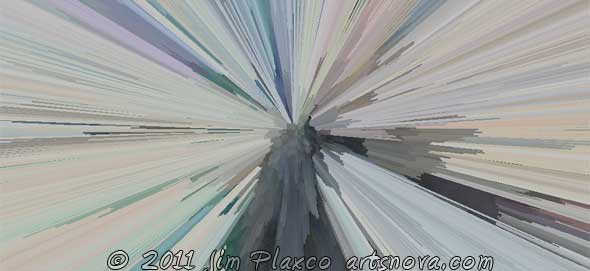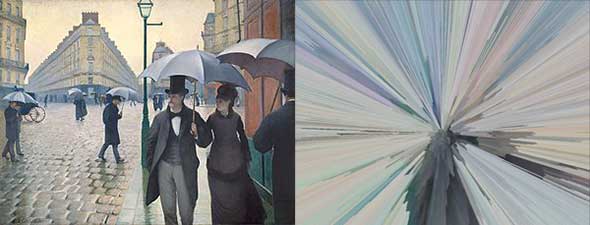Digital Art and Unintended Consequences

An example of unintended consequences in digital art
Yesterday I was working on an image processing program to use as a part of my art creation workflow. I was writing a program to texturize an image so that I could incorporate the output as a layer in a Photoshop document.
As a part of the development process, I decided to use as the source image the painting Paris Street, Rainy Day by French artist Gustave Caillebotte. This is the same image that I used to serve as the "discovered" painting for my article and applet Particle Painting: Name That Painting.
To create the look I was after I needed to use the third dimension, aka the z axis. The addition of the z axis made it possible for me to use that axis as the source of distortion while keeping the correct color information in the x,y plane. Using 3D also allowed me to rotate the image relative to the "camera" thus introducing another level of distortion.
All was going well until I made one small change to the variable I was using to control the distortion along the z axis. This single change took what had been output that was recognizable as the source image and produced an image that was completely unrecognizable. I've used a cropped version of that output to illustrate this post. Below is a side by side comparison of the source image that my program used as input and the resulting output.

Caillebotte's Paris Street, Rainy Day before and after.
This can not be called an algorithmic oops or a glitch. Rather it is a case of parametric discovery. It is this discovery opportunity, whether by design or by accident, that makes digital art such an interesting and revolutionary arena for artistic creation.
It remains to be seen whether or not I will ever make use of this program in a production environment. Even if I don't, what I learned during the process will serve me well in the future. So remember the golden rule of digital art: never be afraid to experiment.
Ad Astra, Jim
| Return to the Blog Index | This entry was posted on Monday, December 12th, 2011 at 6:21 pm and is filed under computer art, Computing, Digital Art.